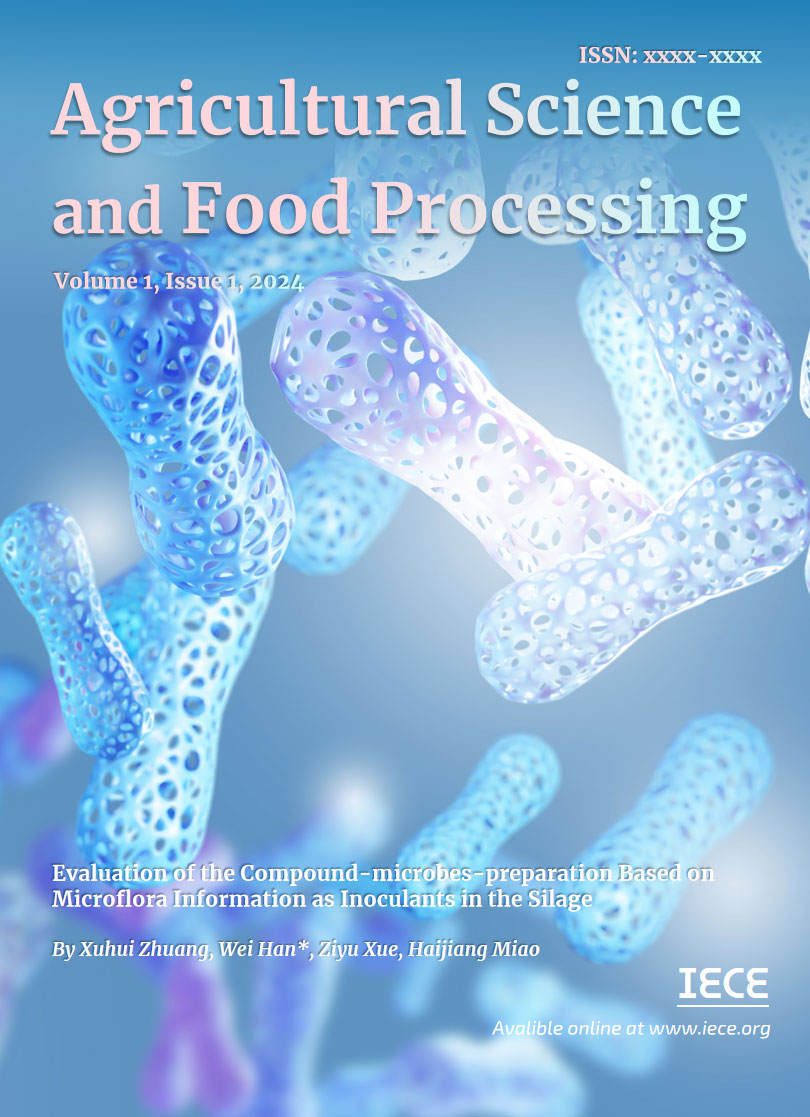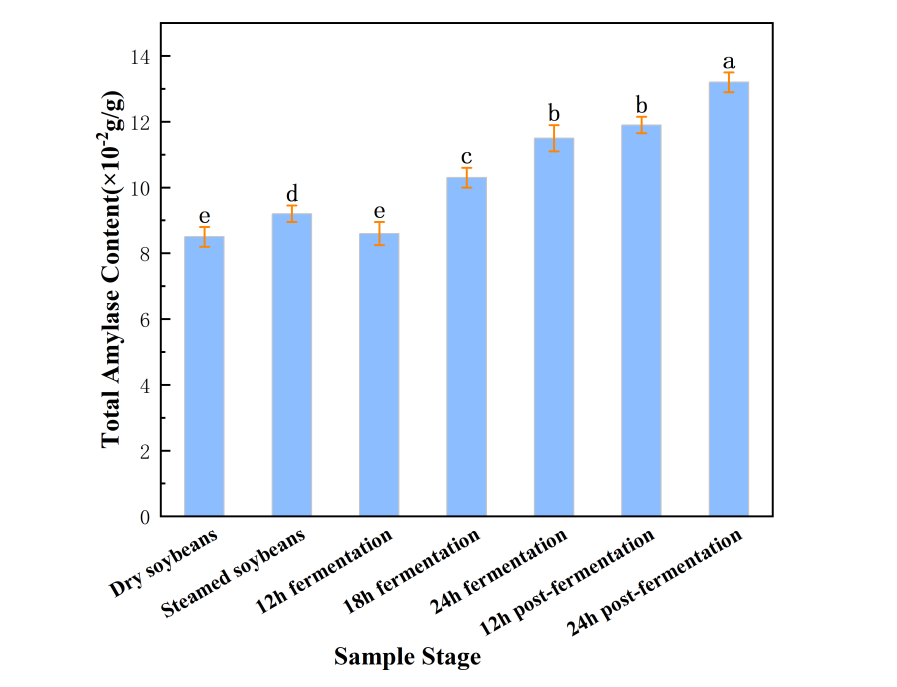Agricultural Science and Food Processing
ISSN: 3066-1579 (Online) | ISSN: 3066-1560 (Print)
Email: [email protected]


 Submit Manuscript
Edit a Special Issue
Submit Manuscript
Edit a Special Issue

[1] Ng, T. B. (Ed.). (2011). Soybean: biochemistry, chemistry and physiology. BoD–Books on Demand.
[2] Colletti, A., Attrovio, A., Boffa, L., Mantegna, S., & Cravotto, G. (2020). Valorisation of by-products from soybean (Glycine max (L.) Merr.) processing. Molecules, 25(9), 2129.
[3] Miyake, Y., Tanaka, K., Okubo, H., Sasaki, S., Furukawa, S., & Arakawa, M. (2018). Soy isoflavone intake and prevalence of depressive symptoms during pregnancy in Japan: baseline data from the Kyushu Okinawa Maternal and Child Health Study. European journal of nutrition, 57, 441-450.
[4] Li, Y., Song, H., Zhang, Z., Li, R., Zhang, Y., Yang, L., ... & Liu, H. (2024). Effects of fermentation with different probiotics on the quality, isoflavone content, and flavor of okara beverages. Food Science & Nutrition, 12(4), 2619-2633.
[5] Lin, Y. L., Lin, M. Y., Liang, C. H., Wu, C. Y., Li, P. H., & Liang, Z. C. (2023). Enhanced Yield of Bioactive Compounds and Antioxidant Activities in Four Fermented Beans of Phellinus linteus Strains (Agaricomycetes) by Solid-State Fermentation. International Journal of Medicinal Mushrooms, 25(9).
[6] Champagne, C. P., Green-Johnson, J., Raymond, Y., Barrette, J., & Buckley, N. (2009). Selection of probiotic bacteria for the fermentation of a soy beverage in combination with Streptococcus thermophilus. Food Research International, 42(5-6), 612-621.
[7] McCue, P., & Shetty, K. (2004). Health benefits of soy isoflavonoids and strategies for enhancement: a review. Critical reviews in food science and nutrition, 44(5), 361-367.
[8] Kim, B., Byun, B. Y., & Mah, J. H. (2012). Biogenic amine formation and bacterial contribution in Natto products. Food Chemistry, 135(3), 2005-2011.
[9] Chaiyasut, C., Kumar, T., Tipduangta, P., & Rungseevijitprapa, W. (2010). Isoflavone content and antioxidant activity of Thai fermented soybean and its capsule formulation. African Journal of Biotechnology, 9(26), 4120-4126.
[10] Kang, J. H., Han, I. H., Sung, M. K., Yoo, H., Kim, Y. G., Kim, J. S., ... & Yu, R. (2008). Soybean saponin inhibits tumor cell metastasis by modulating expressions of MMP-2, MMP-9 and TIMP-2. Cancer letters, 261(1), 84-92.
[11] De Mejia, E., & Ben, O. (2006). Soybean bioactive peptides: A new horizon in preventing chronic diseases. Sexuality, Reproduction and Menopause, 4(2), 91-95.
[12] Dwivedi, S., Singh, V., Sharma, K., Sliti, A., Baunthiyal, M., & Shin, J. H. (2024). Significance of soy-based fermented food and their bioactive compounds against obesity, diabetes, and cardiovascular diseases. Plant Foods for Human Nutrition, 79(1), 1-11.
[13] Ren, N. N., Chen, H. J., Li, Y., Mcgowan, G. W., & Lin, Y. G. (2017). A clinical study on the effect of nattokinase on carotid artery atherosclerosis and hyperlipidaemia. Zhonghua yi xue za zhi, 97(26), 2038-2042.
[14] Oomen, A. G., Hack, A., Minekus, M., Zeijdner, E., Cornelis, C., Schoeters, G., ... & Van Wijnen, J. H. (2002). Comparison of five in vitro digestion models to study the bioaccessibility of soil contaminants. Environmental science & technology, 36(15), 3326-3334.
[15] Sindhi, V., Gupta, V., Sharma, K., Bhatnagar, S., Kumari, R., & Dhaka, N. (2013). Potential applications of antioxidants–A review. Journal of pharmacy research, 7(9), 828-835.
[16] Wu, F. C., Chou, S. Z., & Shih, L. (2013). Factors affecting the production and molecular weight of levan of Bacillus subtilis natto in batch and fed-batch culture in fermenter. Journal of the Taiwan Institute of Chemical Engineers, 44(6), 846-853.
[17] Kuligowski, M., Sobkowiak, D., Polanowska, K., & Jasińska-Kuligowska, I. (2022). Effect of different processing methods on isoflavone content in soybeans and soy products. Journal of Food Composition and Analysis, 110, 104535.
[18] Xu, B. J., & Chang, S. K. (2007). A comparative study on phenolic profiles and antioxidant activities of legumes as affected by extraction solvents. Journal of food science, 72(2), S159-S166.
[19] Gawlik-Dziki, U. (2012). Changes in the antioxidant activities of vegetables as a consequence of interactions between active compounds. Journal of Functional Foods, 4(4), 872-882.
[20] Cho, K. M., Lee, J. H., Yun, H. D., Ahn, B. Y., Kim, H., & Seo, W. T. (2011). Changes of phytochemical constituents (isoflavones, flavanols, and phenolic acids) during cheonggukjang soybeans fermentation using potential probiotics Bacillus subtilis CS90. Journal of Food Composition and Analysis, 24(3), 402-410.
[21] Ju, H. K., Chung, H. W., Hong, S. S., Park, J. H., Lee, J., & Kwon, S. W. (2010). Effect of steam treatment on soluble phenolic content and antioxidant activity of the Chaga mushroom (Inonotus obliquus). Food Chemistry, 119(2), 619-625.
[22] Bouayed, J., Hoffmann, L., & Bohn, T. (2011). Total phenolics, flavonoids, anthocyanins and antioxidant activity following simulated gastro-intestinal digestion and dialysis of apple varieties: Bioaccessibility and potential uptake. Food chemistry, 128(1), 14-21.
[23] Niamnuy, C., Nachaisin, M., Laohavanich, J., & Devahastin, S. (2011). Evaluation of bioactive compounds and bioactivities of soybean dried by different methods and conditions. Food Chemistry, 129(3), 899-906.
[24] Katuwal, N., Raya, B., Dangol, R., Adhikari, B. R., Yadav, K. C., & Upadhyay, A. (2023). Effects of fermentation time on the bioactive constituents of Kinema, a traditional fermented food of Nepal. Heliyon, 9(4).
[25] Sanz, T., & Luyten, H. (2006). Release, partitioning and stability of isoflavones from enriched custards during mouth, stomach and intestine in vitro simulations. Food Hydrocolloids, 20(6), 892-900.
[26] Ma, Y., Zhou, M., & Huang, H. (2014). Changes of heat-treated soymilks in bioactive compounds and their antioxidant activities under in vitro gastrointestinal digestion. European Food Research and Technology, 239, 637-652.
[27] Asni, N. S. M., Surya, R., Misnan, N. M., Lim, S. J., Ismail, N., Sarbini, S. R., & Kamal, N. (2024). Metabolomics insights of conventional and organic tempe during in vitro digestion and their antioxidant properties and cytotoxicity in HCT-116 cells. Food Research International, 195, 114951.
[28] Bisby, R. H., Brooke, R., & Navaratnam, S. (2008). Effect of antioxidant oxidation potential in the oxygen radical absorption capacity (ORAC) assay. Food chemistry, 108(3), 1002-1007.
[29] Pisoschi, A. M., & Pop, A. (2015). The role of antioxidants in the chemistry of oxidative stress: A review. European journal of medicinal chemistry, 97, 55-74.
[30] Verni, M., Verardo, V., & Rizzello, C. G. (2019). How fermentation affects the antioxidant properties of cereals and legumes. Foods, 8(9), 362.
Agricultural Science and Food Processing
ISSN: 3066-1579 (Online) | ISSN: 3066-1560 (Print)
Email: [email protected]

Portico
All published articles are preserved here permanently:
https://www.portico.org/publishers/iece/